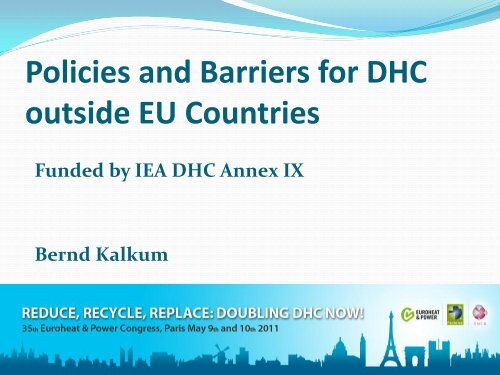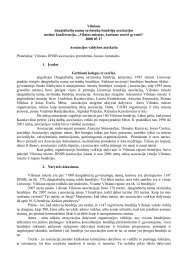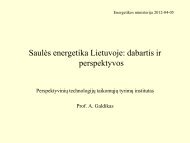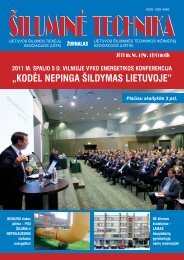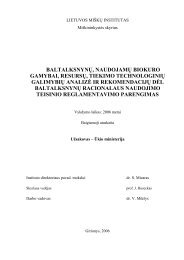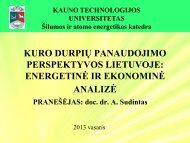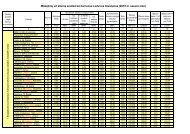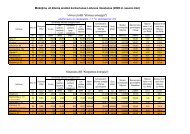Policies and Barriers for DHC outside EU ... - Euroheat & Power
Policies and Barriers for DHC outside EU ... - Euroheat & Power
Policies and Barriers for DHC outside EU ... - Euroheat & Power
You also want an ePaper? Increase the reach of your titles
YUMPU automatically turns print PDFs into web optimized ePapers that Google loves.
Countries selectedBosnia & Herzegovina (BiH)Canada (CAN)China (CHI)Croatia (CRO)Kazakhstan (KAZ)Kosovo (KOS)Macedonia FYR (MAC)Russia (RUS)Serbia (SER)South Korea (KOR)Ukraine (UKR)USA (USA)Uzbekistan (UZB)These countries cover more than 70% of all DH in the world<strong>and</strong> 95% of DH <strong>outside</strong> the <strong>EU</strong>.
Focus of the presentation:•DH Regulation•DH pricing <strong>and</strong> billing•CHP
DH Regulation• Special DH regulation is typically not applied incompetitive heat markets (most old <strong>EU</strong> member countries,USA, CAN).• In countries of the <strong>for</strong>mer Soviet Union <strong>and</strong> China, DHregulation has emerged from the <strong>for</strong>mer centralisedsystems.• In <strong>for</strong>mer Yugoskavia different systems have beendeveloped• In most of these countries, centralised regulatory bodiesaddress DH (exemptions , e.g., China, Serbia).• DH regulation copies typically essential elements ofElectricity Regulation, despite the obvious differences.
Current status
Findings <strong>and</strong> conclusions• Centralised regulations are characterised by:• Uni<strong>for</strong>m rules should apply to all DH Companies.• Tariffs are determined on the same cost base• Trained staff in regulatory bodies is availableDecentralised (municipal) regulations are characterised by:- Lacking uni<strong>for</strong>m rules- Large tariff discrepancies <strong>and</strong> price distortions- Municipalities are often overcharged with regulatory- Lacking/few trained staff in regulatory bodies- Danger that DH becomes the playing field <strong>for</strong> local politics
Conclusions <strong>and</strong> recommendations• DH regulation is needed in absence of competitive heatingalternatives• Apply uni<strong>for</strong>m rules <strong>for</strong> all <strong>DHC</strong>• Supervisions (i.e.,proper application of rules) can beexercised eithe r by central or local entities• Regulation should cover at least:• Determination of cost base• Tariff setting• Licenses• Rules <strong>for</strong> operation <strong>and</strong> management (stipulated in licenses)
DH pricing <strong>and</strong> billing – current status
Consumption-based billingIn most countries of this group, billing used to be donebased on lump-sum tariffs (usually, Curr. Unit/m²),•Advantage: simplicity both <strong>for</strong> DH operators <strong>and</strong>customers•Disadvantage: Lacking incentive to save energy <strong>and</strong>reduce costs.Converting this system to consumption-based billing inChina subject of the so-called „Heat re<strong>for</strong>m“.In other countries, the initiative has typically come fromthe DH Companies, when facing increasing competionfrom other heating options.
Consumption-based billingThere is a clear tendency to implement consumption-basedbilling.•In China the central government pushes consumptionbasedbilling, but implementation at the local level is slow.•In the countries of the <strong>for</strong>mer SU, consumption-basedbilling is allowed, but typically neither en<strong>for</strong>ced nor activelysupported by local authorities.•In MAC <strong>and</strong> CRO it is applied, in KOS legally requested butnot yet applied. In SR, most DH Companies want it, but localauthorities are still resisting.•Consumption-based billing is typically applied in CAN,KOR, <strong>and</strong> USA.
Good practice - Kosovo• Consumption-based billing is legally requested (but not yeten<strong>for</strong>ced due to lack of meters)• A two-part tariff is applied (even without metering)• Tariff calculated based on cost <strong>and</strong> dem<strong>and</strong> <strong>for</strong>ecast• Clear rules <strong>for</strong> cost-base• Profit included (return of regulated assets base)• ERC explains in detail reasons <strong>for</strong> not accepting specificcosts• Losses <strong>and</strong> profits of the previous year affect the approvedcost base of the current year.• But: Bad debts are not accepted as costs
DH Pricing <strong>and</strong> billing-Recommendations• In regulated DH markets, uni<strong>for</strong>m pricing rules need to beapplied (good example: Kosovo)• Decentralised pricing responsibilities lead to pricemismatch <strong>and</strong> price distortions (such as in Serbia)• A decentralised variant would comprise (recommendedoption <strong>for</strong> China):• Definition of uni<strong>for</strong>m rules <strong>for</strong> cost base, tariff setting <strong>and</strong>billing,• Local/regional supervision of proper application of the rules• Application of a two-part tariff reflecting variable <strong>and</strong> fixedcosts (particularly important <strong>for</strong> economies in transition)
CHP – Current status
Status of CHPShares of CHP in total heat generation capacity isdifferent, but in general sub-optimal.The biggest markets are:•China (2006): 2,600 CHP units with over 80 GW ofcapacity, providing about 18% of the thermal generationcapacity•Russia: Heat supplied by CHP amounts to some 30%•In CEE, conditions <strong>for</strong> CHP are difficult:• Ukraine: Many old CHP plants have shrunk to heat only boilerplants due to technical problems• Serbia: Most CHP plants have stopped production
Problems of CHP utilisation• Nation-wide average numbers say nothing about the rationale of CHPutilisation.• In some cases, practically all heat may come from CHP (e.g., UlanBator/Mongolia), i.e., the share of CHP in total capacity may be farabove economic optimum.• In China, there can be hundreds of DH Companies in one city, whileonly a few are served by CHP.• In Russia, there is little incentive to develop any CHP. There<strong>for</strong>e, theoutdated CHP per<strong>for</strong>mance is close to modern pure power(condensing) plants.• In general, there are no clear opinions <strong>and</strong> guidelines regarding theoptimal sizing of CHP.• Steam is usually extracted at relative high pressures resulting inunnecessary electricity losses.• Typically low overall efficiencies• There are only a few examples of reasonable heat planning <strong>for</strong> cities.
Good practice – Skopje/MA• Ownership <strong>and</strong> regulatory functions clearly separated• DH is owned by a private investor• Network is owned by Municipality <strong>and</strong> leased to <strong>DHC</strong>• Licenses <strong>for</strong> generation, distribution, <strong>and</strong> supply• Rehabilitation without funds from IFIs• High collection rate of 95%• New CHP CCP plant; more are planned to supply thewhole system.• Heat from CHP cheaper than from HoB (but no feedintariff system)
CHP – Promotion• Promotion of CHP is mostly limited to small plants(typically up to 10 MWe) using RES <strong>and</strong>, sometimes,natural gas.• This has obviously been promoted by the corresponding<strong>EU</strong> policies <strong>and</strong> is applied by potential <strong>EU</strong> members.• China has adopted a less vigorous approach, which actuallydoes not promote small scale CHP with RES.• There are no particular promotion programmes to supportlarger CHP plants.• Clear policies <strong>and</strong> transparent rules <strong>for</strong> operating largerCHP plants are mostly lacking.
CHP - Recommendations• DH Companies <strong>and</strong> government are mostly looking <strong>for</strong>private investors, but transparent <strong>and</strong> clear legalframeworks are missing; rules are fixed case by case• Clear <strong>and</strong> transparent feed-in tariff systems <strong>for</strong> CHP(including larger facilities) required• Sizing the plants needs to be based on reasonable heatplanning (instead of outdated norms)• Heat planning is mostly not applied or became a<strong>for</strong>gotten art (FY).
Additional in<strong>for</strong>mationThe report will be publically available by summer2011 at http://www.iea-dhc.org/Contact:Arto Nuorkivi, Email: energy@nuorkivi.fiBernd Kalkum, Email: bk@euc-kalkum.com


